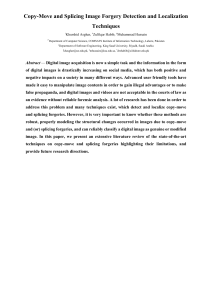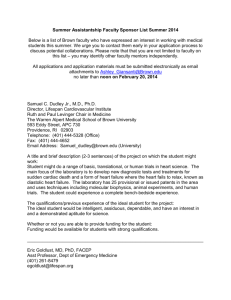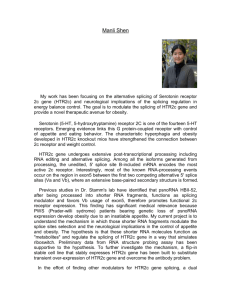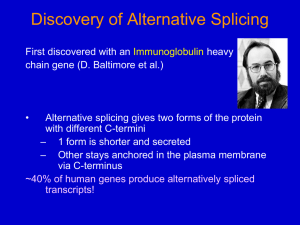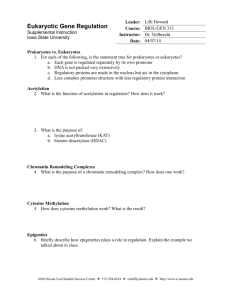dna splicing rules - Towson University
advertisement
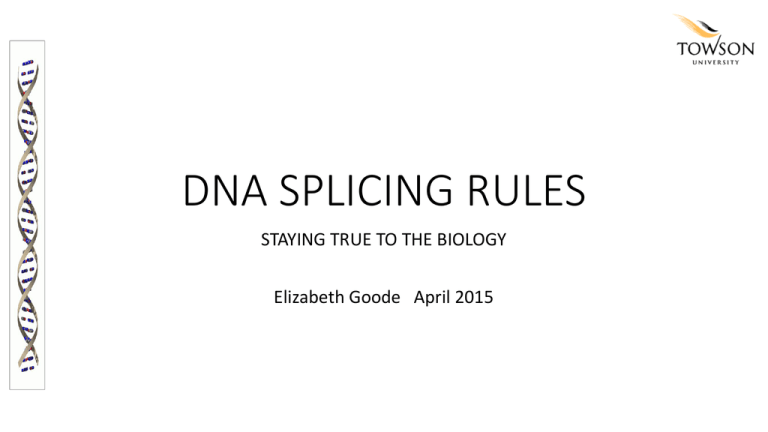
DNA SPLICING RULES
STAYING TRUE TO THE BIOLOGY
Elizabeth Goode April 2015
HISTORY
HISTORY
• TOM HEAD introduced a mathematical model of the biological activity
we call “DNA splicing.”
[Tom Head, 1987]
HISTORY
• TOM HEAD introduced a mathematical model of the biological activity
we call “DNA splicing.”
[Tom Head, 1987]
• The model provided a way to study the generative power of doublestranded DNA (dsDNA) in the presence of enzymes that cut and paste
in a site-specific manner – i.e., the computational power of the
splicing operation.
HISTORY
• Over 5,000 articles and books have been published about DNA
splicing systems since Head introduced the concept in 1987.
HISTORY
• Over 5,000 articles and books have been published about DNA
splicing systems since Head introduced the concept in 1987.
• Algebra and graph theory have been used to attack the questions that
arise in the area of DNA splicing theory.
HISTORY
• Over 5,000 articles and books have been published about DNA
splicing systems since Head introduced the concept in 1987.
• Algebra and graph theory have been used to attack the questions that
arise in the area of DNA splicing theory.
• Leonard Adleman examined the possibility of using DNA and its
various biochemical operations to crack the RSA encryption code.
DNA-computing was born.
[Adleman 1994, 20-var SAT]
What is DNA?
Double-stranded DNA (dsDNA) is a
double helix (twisted ladder) with a
sugar-phosphate backbone. The
“rungs” are made of nucleotides held
together in a very specific orientation
by hydrogen bonding.
What is DNA?
What is DNA?
What is DNA splicing?
What is DNA splicing?
• Splicing is the cutting and pasting of dsDNA.
• Restriction enzymes are proteins that can perform site-specific cutting
of dsDNA.
• By site-specific cutting we mean the enzymes can recognize a specific
sequence of nucleotides and perform a specific type of cut at that
site.
Example: Bgl II
What is DNA splicing?
Example: Bgl II
What is DNA splicing?
Example: Bgl II
At 1.5A resolution
1.5 × 10−7 mm
Splicing as an Operation on dsDNA
Splicing as an Operation on dsDNA
Splicing as an Operation on dsDNA
Splicing as an Operation on dsDNA
Splicing as an Operation on dsDNA
Modeling the splicing of dsDNA
Modeling the splicing of dsDNA
Modeling the splicing of dsDNA
• The dsDNA that is initially in the test tube is represented as a set I.
Modeling the splicing of dsDNA
• The dsDNA that is initially in the test tube is represented as a set I.
I = 𝑆1 , 𝑆2
𝑆1 = αGCCGCACCGGCβ
𝑆2 = γCACCACGTGδ
Modeling the splicing of dsDNA
• The dsDNA that is initially in the test tube is represented as a set I.
I = 𝑆1 , 𝑆2
𝑆1 = αGCCGCACCGGCβ
𝑆2 = γCACCACGTGδ
Modeling the splicing of dsDNA
• The dsDNA that is initially in the test tube is represented as a set I.
• The action of the restriction (cutting) enzymes is encoded by rules that
belong to set R.
I = 𝑆1 , 𝑆2
𝑆1 = αGCCGCACCGGCβ
𝑆2 = γCACCACGTGδ
Modeling the splicing of dsDNA
• The dsDNA that is initially in the test tube is represented as a set I.
• The action of the restriction (cutting) enzymes is encoded by rules that
belong to set R.
I = 𝑆1 , 𝑆2
𝑆1 = αGCCGCACCGGCβ
𝑆2 = γCACCACGTGδ
R= (GCCN,NNN,NGGC) , (CAC,NNN,GTG)
Modeling the splicing of dsDNA
• The dsDNA that is initially in the test tube is represented as a set I.
• The action of the restriction (cutting) enzymes is encoded by rules that
belong to set R.
I = 𝑆1 , 𝑆2
𝑆1 = αGCCGCACCGGCβ
𝑆2 = γCACCACGTGδ
R= (GCCN,NNN,NGGC) , (CAC,NNN,GTG)
T4 ligase pastes sticky end together
Modeling the Cutting using Rule Sets
Modeling the Cutting using Rule Sets
𝛼
𝑝
𝑠
( p, s, q )
𝑞
𝛽
Modeling the Cutting using Rule Sets
𝛼
𝑝
𝑠′
𝑠′′
( p, s, q )
𝑞
𝛽
Modeling the Cutting using Rule Sets
𝛼
𝑝
𝑠′
𝑠′′
𝑞
𝛽
𝑠′′
𝑣
𝛿
( p, s, q )
𝛾
𝑢
𝑠′
( u, s, v )
Modeling the Cutting using Rule Sets
𝛼
𝑝
𝑠′
𝑠′′
𝑞
𝛽
𝑠′′
𝑣
𝛿
( p, s, q )
𝛾
𝑢
𝑠′
( u, s, v )
Modeling the Cutting using Rule Sets
𝛼
𝛾
𝑝
𝑠′
𝑢
𝑠′
( p, s, q ) ( u, s, v )
𝑠′′
𝑞
𝛽
𝑠′′
𝑣
𝛿
Modeling the Cutting using Rule Sets
𝛼
𝛾
𝑝
𝑠′
𝑢
𝑠′
( p, s, q ) ( u, s, v )
𝑠′′
𝑞
𝛽
𝑠′′
𝑣
𝛿
Modeling the Cutting using Rule Sets
𝛼
𝑝
𝑠′
𝑠′′
( p, s, q ) ( u, s, v )
𝑣
𝛿
Modeling the Cutting using Rule Sets
𝛾
𝑢
𝛼
𝑠′
𝑠′′
𝑞
𝑝
𝛽
𝑠′
𝑠′′
( p, s, q ) ( u, s, v )
𝑣
𝛿
What is a Formal Language?
What is a Formal Language?
We can think of a formal language as a set of strings written over a
finite alphabet. In general, two alphabet letters suffice.
What is a Formal Language?
We can think of a formal language as a set of strings written over a
finite alphabet. In general, two alphabet letters suffice.
Example: A = {a, b}
What is a Formal Language?
We can think of a formal language as a set of strings written over a
finite alphabet. In general, two alphabet letters suffice.
Example: A = {a, b}
L1 = aa + ab + ba + bb
What is a Formal Language?
We can think of a formal language as a set of strings written over a
finite alphabet. In general, two alphabet letters suffice.
Example: A = {a, b}
L1 = aa + ab + ba + bb
L2 = ab*a
What is a Formal Language?
We can think of a formal language as a set of strings written over a
finite alphabet. In general, two alphabet letters suffice.
Example: A = {a, b}
L1 = aa + ab + ba + bb
L2 = ab*a
L3 = a(bb) *a
What is a Formal Language?
We can think of a formal language as a set of strings written over a
finite alphabet. In general, two alphabet letters suffice.
Example: A = {a, b}
L1 = aa + ab + ba + bb
L2 = ab*a
L3 = a(bb) *a
L4 = a(bb) *a + ab + ba + bb
Formal Language Characterization Schemas
Formal Language Characterization Schemas
The Chomsky Hierarchy of Languages classifies languages into families.
[Noam Chomsky 1956,1959]
Formal Language Characterization Schemas
The Chomsky Hierarchy of Languages classifies languages into families.
[Noam Chomsky 1956,1959]
REGULAR
Formal Language Characterization Schemas
The Chomsky Hierarchy of Languages classifies languages into families.
[Noam Chomsky 1956,1959]
REGULAR
CONTEXT-FREE
Formal Language Characterization Schemas
The Chomsky Hierarchy of Languages classifies languages into families.
[Noam Chomsky 1956,1959]
REGULAR
CONTEXT-FREE
CONTEXT-SENSITIVE
Formal Language Characterization Schemas
The Chomsky Hierarchy of Languages classifies languages into families.
[Noam Chomsky 1956,1959]
REGULAR
RECURSIVE
CONTEXT-FREE
CONTEXT-SENSITIVE
Formal Language Characterization Schemas
The Chomsky Hierarchy of Languages classifies languages into families.
[Noam Chomsky 1956,1959]
REGULAR
RECURSIVELY
ENUMERABLE
RECURSIVE
CONTEXT-FREE
CONTEXT-SENSITIVE
Computational Models for Formal Languages
Computational Models for Formal Languages
• The “Machine” Model
Computational Models for Formal Languages
• The “Machine” Model
• Finite Automata and Regular Languages
Computational Models for Formal Languages
• The “Machine” Model
• Finite Automata and Regular Languages
L2 = ab*a
Computational Models for Formal Languages
• The “Machine” Model
• Finite Automata and Regular Languages
L2 = ab*a
Computational Models for Formal Languages
• The “Machine” Model
• Finite Automata and Regular Languages
L2 = ab*a
Computational Models for Formal Languages
• The “Machine” Model
• Finite Automata and Regular Languages
b
L2 = ab*a
a
a
Computational Models for Formal Languages
• The “Machine” Model
• Finite Automata and Regular Languages
[McCulloch & Pitts 1943, Kleene 1956,
Huffman 1954, Moore 1956, Mealy 1955]
Computational Models for Formal Languages
• The “Machine” Model
• Finite Automata and Regular Languages
[McCulloch & Pitts 1943, Kleene 1956,
Huffman 1954, Moore 1956, Mealy 1955]
• Push-Down Automata and Context-Free Languages
Deterministic ⊂ Non-deterministic
[Oettinger 1961, Bar Hillel, Perles & Shamir 1961,
Cantor 1962, Floyd 1962, Ginsburg & Rose 1963,
Chomsky & Schutzenberger 1963, Ogden 1968, Wise 1976]
Computational Models for Formal Languages
• The “Machine” Model
• Finite Automata and Regular Languages
[McCulloch & Pitts 1943, Kleene 1956,
Huffman 1954, Moore 1956, Mealy 1955]
• Push-Down Automata and Context-Free Languages
Deterministic ⊂ Non-deterministic
[Oettinger 1961, Bar Hillel, Perles & Shamir 1961,
Cantor 1962, Floyd 1962, Ginsburg & Rose 1963,
Chomsky & Schutzenberger 1963, Ogden 1968, Wise 1976]
• Linear-Bounded Automata and Context-Sensitive Languages
Turing machine with finite tape
[Greibach 1963, 1966, Gross 1964]
Computational Models for Formal Languages
• The “Machine” Model
• Finite Automata and Regular Languages
[McCulloch & Pitts 1943, Kleene 1956,
Huffman 1954, Moore 1956, Mealy 1955]
• Push-Down Automata and Context-Free Languages
Deterministic ⊂ Non-deterministic
[Oettinger 1961, Bar Hillel, Perles & Shamir 1961,
Cantor 1962, Floyd 1962, Ginsburg & Rose 1963,
Chomsky & Schutzenberger 1963, Ogden 1968, Wise 1976]
• Linear-Bounded Automata and Context-Sensitive Languages
Turing machine with finite tape
[Greibach 1963, 1966, Gross 1964]
• Universal Turing Machines and Recursively Enumerable Languages
Turing machine with infinite tape [Turing 1936, Kleene 1936, Post 1946, Rice 1953, Minsky 1961]
Computational Models for Formal Languages
• The “Grammar” Model
Computational Models for Formal Languages
• The “Grammar” Model
• Right (Left) Linear grammars and Regular Languages
Computational Models for Formal Languages
• The “Grammar” Model
• Right (Left) Linear grammars and Regular Languages
L2 = ab*a
Computational Models for Formal Languages
• The “Grammar” Model
• Right (Left) Linear grammars and Regular Languages
L2 = ab*a
S -> aA
A -> a | bB
B -> a | bB
Computational Models for Formal Languages
• The “Grammar” Model
• Right (Left) Linear Grammars and Regular Languages
Rules have form S -> aB | bD | ∈
[Chomsky 1956-59, Miller 1958]
Computational Models for Formal Languages
• The “Grammar” Model
• Right (Left) Linear Grammars and Regular Languages
Rules have form S -> aB | bD | ∈
• Context-Free Grammars and Languages
Rules can be two-sided
[Chomsky 1956-59, Miller 1958]
[Chomsky 1956-63, Backus 1959, Naur 960,
Ginsburg & Rice 1962, Rosenkrantz 1967]
• Context-Sensitive Grammars and Languages
Rules have form aAb -> aBb
[Kuroda 1964]
• Semi-Thue (type 0) grammars and Recursively Enumerable Languages
Undecideability of word problem for semi-Thue systems
?
𝑢 →𝑣
[Thue, 1914, Emil Post & A.A. Markov, 1942]
Computational Models for Formal Languages
• The “Splicing” Model
• Gheorghe Paun proved that splicing is Turing complete – splicing systems not
having finite initial sets can generate all languages that can be generated by the
universal Turing machine.
[1995]
Computational Models for Formal Languages
• The “Splicing” Model
• Gheorghe Paun proved that splicing is Turing complete – splicing systems not
having finite initial sets can generate all languages that can be generated by the
universal Turing machine.
[1995]
• Pixton proved that all finitely generated splicing languages are regular.
[1994]
Computational Models for Formal Languages
• The “Splicing” Model
• Gheorghe Paun proved that splicing is Turing complete – splicing systems not
having finite initial sets can generate all languages that can be generated by the
universal Turing machine.
[1995]
• Pixton proved that all finitely generated splicing languages are regular.
[1994]
• There are assorted results “in-between” the classes of languages belonging to
the regular set and the universal set of languages, primarily due to Gheorghe
Paun.
Computational Models for Formal Languages
• The “Splicing” Model
Computational Models for Formal Languages
• The “Splicing” Model
• We denote a splicing schema 𝜎 as a finite alphabet A and a set of rules,
R that is a subset of a cross-product of copies of A.
Computational Models for Formal Languages
• The “Splicing” Model
• We denote a splicing schema 𝜎 as a finite alphabet A and a set of rules,
R that is a subset of a cross-product of copies of A.
• A splicing system is a splicing schema and an initial set of strings (𝜎, 𝐼).
Computational Models for Formal Languages
• The “Splicing” Model
• We denote a splicing schema 𝜎 as a finite alphabet A and a set of rules,
R that is a subset of a cross-product of copies of A.
• A splicing system is a splicing schema and an initial set of strings (𝜎, 𝐼).
• The language associated with a splicing system (𝜎, 𝐼) is the set of all wellformed strings that are present at any time during the iterated cutting
and pasting.
Rules for Splicing
Rules for Splicing
Splicing languages that respect the biology
Rules have form (c,x,d) (p,x,q) and handedness
[Head 1987]
Rules for Splicing
Splicing languages that respect the biology
Rules have form (c,x,d) (p,x,q) and handedness
REGULAR
[Head 1987]
Rules for Splicing
Splicing languages that respect the biology
Rules have form (c,x,d) (p,x,q) and handedness
Splicing languages with uniform rules are Strictly Locally Testable
Rules have form (1,x,1) (1,w,1) where x,w ∈ AP for some P > 0
REGULAR
[Head 1987]
[Head 1987]
Rules for Splicing
Splicing languages that respect the biology
Rules have form (c,x,d) (p,x,q) and handedness
Splicing languages with uniform rules are Strictly Locally Testable
Rules have form (1,x,1) (1,w,1) where x,w ∈ AP for some P > 0
A constant in a language L is a substring x
such that if cxd and pxq are words in L, then
cxq and pxd are also in L.
REGULAR
[Head 1987]
[Head 1987]
Rules for Splicing
Semi-Simple Splicing Languages
Rule form is (a, 1; b, 1) with a,b in A
REGULAR
Rules for Splicing
Semi-Simple Splicing Languages
Rule form is (a, 1; b, 1) with a,b in A
They are precisely the Strictly Locally Testable Languages
REGULAR
[Goode & Pixton 1999]
Rules for Splicing
Semi-Simple Splicing Languages
Rule form is (a, 1; b, 1) with a,b in A
They are precisely the Strictly Locally Testable Languages
Rule (a, 1; b, 1) cuts & pastes these strings:
𝜇
𝛾
𝑎
𝑏
𝜂
𝛿
REGULAR
[Goode & Pixton 1999]
Rules for Splicing
Semi-Simple Splicing Languages
Rule form is (a, 1; b, 1) with a,b in A
They are precisely the Strictly Locally Testable Languages
Rule (a, 1; b, 1) cuts & pastes these strings:
𝜇
𝛾
𝑎
𝑏
Producing these strings:
𝜂
𝛿
REGULAR
[Goode & Pixton 1999]
Rules for Splicing
Semi-Simple Splicing Languages
Rule form is (a, 1; b, 1) with a,b in A
They are precisely the Strictly Locally Testable Languages
Rule (a, 1; b, 1) cuts & pastes these strings:
𝜇
𝛾
𝑎
𝑏
𝜂
𝛿
Producing this string:
𝜇
𝑎
REGULAR
𝛿
[Goode & Pixton 1999]
Rules for Splicing
Semi-Simple Splicing Languages
Rule form is (a, 1; b, 1) with a,b in A
They are precisely the Strictly Locally Testable Languages
Rule (a, 1; b, 1) cuts & pastes these strings:
𝜇
𝛾
𝑎
𝑏
𝜂
𝛿
Producing this string:
𝜇
𝛾
𝑎
𝑏
REGULAR
𝛿
𝜂
[Goode & Pixton 1999]
Rules for Splicing
Semi-Simple Splicing Languages
Rule form is (a, 1; b, 1) with a,b in A
They are precisely the Strictly Locally Testable Languages
REGULAR
[Goode & Pixton 1999]
Rules for Splicing
Semi-Simple Splicing Languages
Rule form is (a, 1; b, 1) with a,b in A
They are precisely the Strictly Locally Testable Languages
They can be reflexive languages.
REGULAR
[Goode & Pixton 1999]
Rules for Splicing
Semi-Simple Splicing Languages
Rule form is (a, 1; b, 1) with a,b in A
They are precisely the Strictly Locally Testable Languages
They can be reflexive languages.
Ak ⊆ Constants of L
REGULAR
[Goode & Pixton 1999]
Rules for Splicing
Semi-Simple Splicing Languages
Rule form is (a, 1; b, 1) with a,b in A
They are precisely the Strictly Locally Testable Languages
They can be reflexive languages.
Ak ⊆ Constants of L
A reflexive rule has the form (u, v; u, v).
Reflexive rule sets have the property that
if (u, v; u’, v’) is in the rule set, then
so are (u, v; u, v) and (u’, v’; u’, v’).
REGULAR
[Goode & Pixton 1999]
Rules for Splicing
Semi-Simple Splicing Languages
Rule form is (a, 1; b, 1) with a,b in A
They are precisely the Strictly Locally Testable Languages
They can be reflexive languages.
Ak ⊆ Constants of L
A reflexive rule has the form (u, v; u, v).
Reflexive rule sets have the property that
if (u, v; u’, v’) is in the rule set, then
so are (u, v; u, v) and (u’, v’; u’, v’).
The sites uv and u’v’ are constants in L.
REGULAR
[Goode & Pixton 1999]
Rules for Splicing
Semi-Simple Splicing Languages
Rule form is (a, 1; b, 1) with a,b in A
They are precisely the Strictly Locally Testable Languages
They can be reflexive languages.
Ak ⊆ Constants of L
[Goode & Pixton 1999]
Rules for Splicing
Semi-Simple Splicing Languages
Rule form is (a, 1; b, 1) with a,b in A
They are precisely the Strictly Locally Testable Languages
They can be reflexive languages.
Ak ⊆ Constants of L
If uav and sbt are words in L and the rule (a, 1; b, 1) is in R,
[Goode & Pixton 1999]
Rules for Splicing
Semi-Simple Splicing Languages
Rule form is (a, 1; b, 1) with a,b in A
They are precisely the Strictly Locally Testable Languages
They can be reflexive languages.
Ak ⊆ Constants of L
If uav and sbt are words in L and the rule (a, 1; b, 1) is in R,
then splicing can occur, producing the string uat.
[Goode & Pixton 1999]
Rules for Splicing
Semi-Simple Splicing Languages
Rule form is (a, 1; b, 1) with a,b in A
They are precisely the Strictly Locally Testable Languages
They can be reflexive languages.
Ak ⊆ Constants of L
If uav and sbt are words in L and the rule (a, 1; b, 1) is in R,
then splicing can occur, producing the string uat.
One rule models the action of 2 enzymes.
[Goode & Pixton 1999]
Rules for Splicing
Semi-Simple Splicing Languages
Rule form is (a, 1; b, 1) with a,b in A
They are precisely the Strictly Locally Testable Languages
They can be reflexive languages.
Ak ⊆ Constants of L
If uav and sbt are words in L and the rule (a, 1; b, 1) is in R,
then splicing can occur, producing the string uat.
One rule models the action of 2 enzymes.
The biology also allows the formation also of word sbt.
[Goode & Pixton 1999]
Rules for Splicing
Semi-Simple Splicing Languages
Rule form is (a, 1; b, 1) with a,b in A
They are precisely the Strictly Locally Testable Languages
They can be reflexive languages.
Ak ⊆ Constants of L
If uav and sbt are words in L and the rule (a, 1; b, 1) is in R,
then splicing can occur, producing the string uat.
One rule models the action of 2 enzymes.
The biology also allows the formation also of word sbt.
In order to model this we turn to new types of rule sets.
[Goode & Pixton 1999]
Rules for Splicing
Consider a rule of the form (a, 1; a, 1) with a in A.
Rules for Splicing
Consider a rule of the form (a, 1; a, 1) with a in A.
This type of rule is reflexive.
(Simple rule)
Rules for Splicing
Consider a rule of the form (a, 1; a, 1) with a in A.
This type of rule is reflexive.
Now consider a rule of the form (a, 1; b, 1) with a in A.
(Simple rule)
(Semi-simple rule)
Rules for Splicing
Consider a rule of the form (a, 1; a, 1) with a in A.
This type of rule is reflexive.
Now consider a rule of the form (a, 1; b, 1) with a in A.
If uav and sbt are words in L and the rule (a, 1; b, 1) is in R,
then splicing can occur, producing the string uat.
(Simple rule)
(Semi-simple rule)
Rules for Splicing
Consider a rule of the form (a, 1; a, 1) with a in A.
This type of rule is reflexive.
Now consider a rule of the form (a, 1; b, 1) with a in A.
If uav and sbt are words in L and the rule (a, 1; b, 1) is in R,
then splicing can occur, producing the string uat.
The biology allows the formation also of word sbt.
So we include a rule of the form (b, 1; a, 1).
(Simple rule)
(Semi-simple rule)
Rules for Splicing
Consider a rule of the form (a, 1; a, 1) with a in A.
This type of rule is reflexive.
Now consider a rule of the form (a, 1; b, 1) with a in A.
(Simple rule)
(Semi-simple rule)
If uav and sbt are words in L and the rule (a, 1; b, 1) is in R,
then splicing can occur, producing the string uat.
The biology allows the formation also of word sbt.
So we include a rule of the form (b, 1; a, 1).
We call this the “symmetric twin” of (a, 1; b, 1). Symmetry respects the biology.
Rules for Splicing
The form of rules can reveal or obscure the biological activity.
Rules for Splicing
The form of rules can reveal or obscure the biological activity.
Ex: Head’s original notation was intended to show the “sticky ends” or “crossing” of
the restriction enzyme cutting sites. (u, x, v) (p, x, q)
Rules for Splicing
The form of rules can reveal or obscure the biological activity.
Ex: Head’s original notation was intended to show the “sticky ends” or “crossing” of
the restriction enzyme cutting sites. (u, x, v) (p, x, q)
Ex: A Pixton-type rule of the form (u, v ; u’, v’) does not necessarily respect the
biological notion of the crossing of the restriction site.
Rules for Splicing
The form of rules can reveal or obscure the biological activity.
Ex: Head’s original notation was intended to show the “sticky ends” or “crossing” of
the restriction enzyme cutting sites.
Ex: A Pixton-type rule of the form (u, v ; u’, v’) does not necessarily respect the
biological notion of the crossing of the restriction site.
𝛼
𝑝
𝑥
𝑞
𝛽
𝛼
𝑠
𝑥
𝑡
𝛽
Rules for Splicing
The form of rules can reveal or obscure the biological activity.
Ex: Head’s original notation was intended to show the “sticky ends” or “crossing” of
the restriction enzyme cutting sites.
Ex: A Pixton-type rule of the form (u, v ; u’, v’) does not necessarily respect the
biological notion of the crossing of the restriction site.
But it can:
(px, q ; sx, t) or (p, xq ; s, xt)
𝛼
𝑝
𝑥
𝑞
𝛽
𝛼
𝑠
𝑥
𝑡
𝛽
Rules for Splicing
The form of rules can reveal or obscure the biological activity.
Rules for Splicing
The form of rules can reveal or obscure the biological activity.
Yuhani Yusof and E Goode decided to rewrite the rules in a form that makes the
biological activity apparent.
Simple rules: (a, 1; a, 1) -> (a, 1, 1: a, 1, 1) or (1, 1, a: 1, 1, a) or (1, a, 1: 1, a, 1)
Rules for Splicing
The form of rules can reveal or obscure the biological activity.
Yuhani Yusof and E Goode decided to rewrite the rules in a form that makes the
biological activity apparent.
Simple rules: (a, 1; a, 1) -> (a, 1, 1: a, 1, 1) or (1, 1, a: 1, 1, a) or (1, a, 1: 1, a, 1)
Semi-simple rules: (a, 1: b, 1) -> (a, 1, 1: b, 1, 1)
Rules for Splicing
The form of rules can reveal or obscure the biological activity.
Yuhani Yusof and E Goode decided to rewrite the rules in a form that makes the
biological activity apparent.
Simple rules: (a, 1; a, 1) -> (a, 1, 1: a, 1, 1) or (1, 1, a: 1, 1, a) or (1, a, 1: 1, a, 1)
Semi-simple rules: (a, 1; b, 1) -> (a, 1, 1: b, 1, 1)
Semi-null rules: (u, 1; v, 1) -> (u, 1, 1: v, 1, 1) or (u1, w, 1: v1, w, 1)
Rules for Splicing
The form of rules can reveal or obscure the biological activity.
Yuhani Yusof and E Goode decided to rewrite the rules in a form that makes the
biological activity apparent.
Simple rules: (a, 1; a, 1) -> (a, 1, 1: a, 1, 1) or (1, 1, a: 1, 1, a) or (1, a, 1: 1, a, 1)
Semi-simple rules: (a, 1; b, 1) -> (a, 1, 1: b, 1, 1)
Semi-null rules: (u, 1; v, 1) -> (u, 1, 1: v, 1, 1) or (u1, w, 1: v1, w, 1)
Theorems include: The languages generated by simple semi-simple and semi-null
systems are exactly those generated by the corresponding rule sets written in the
Yusof-Goode rule notation.
Rules for Splicing
As the biology demands that symmetry and reflexivity be respected, the YusofGoode model adopted the constraint that the splicing system would always be built
to include any rules required to ensure its reflexive and symmetric closure.
Rules for Splicing
As the biology demands that symmetry and reflexivity be respected, the YusofGoode model adopted the constraint that the splicing system would always be built
to include any rules required to ensure its reflexive and symmetric closure.
These notions become important in the investigation of the limit language
associated with a splicing schema.
Wet Splicing of dsDNA
Planning
Experiment
Planning
Experiment
Planning
Experiment
From Yuhani on 03/12/11
Dear Dr Liz,
These are actually my plan tomorrow:
Run on the double 8-well
1. 3 alpha-beta+3 gamma-delta+1 combination alpha-beta &
gamma-delta of the PCR Rx#4 +LMW ladder 2. 1 alpha-beta, 1
gamma-delta, 1 combination of alpha-beta & gamma-delta of
the Purification PCR Rx#3 (that I did last Thursday)-I'll take 5 ul
each since it is suggested from Qiagen purification kit to run
the purification product with 5ul purification lambda with 1 ul
6X loading dye, 1 combination of alpha-beta that you purified,
1 combination alpha-beta & gamma-delta (2nd) purified, 1
If all look goods, I will do the RE digestion and ligation after that
and run for final results.
Just two question that I want to ensure.
1.If I did all the digestion and ligation sample-mean until the
last sample of Lane 8 that stored in -70 degC, how long that I
need to wait to run all the sample (Lane 1-Lane 8) on 3% gel.
2. The RE digestion and ligation sample should be done in 37
degC. So, I 'll put in the heater box at 37 degC and take out the
sample from that with the time t =5, 10.....that I plan. Is it
right?
Cutting out Stands 1 and 2
from E.Coli genome
Purification of Cut outs from E.Coli
PCR results from purified DNA
for Initial Strand 1
1
2
3
4
5
6
7
8
9
Dynamics of the DNA splicing system:
Lanes 1 and 9 contain DNA Ladder
Limit language is apparent in Lanes 4, 5, 6, 7
Transient strings appear in Lanes 3 – 7
Computational Models for Formal Languages
• The “Splicing” Model
Splicing languages with uniform rules are Strictly Locally Testable
Rules have form (c,x,d) (p,x,q) and handedness
[Head 1987]
Semi-Simple Splicing Languages
Rule = 𝑎, 1; 𝑏, 1 with a,b in A
Non-constant word length is bounded below; SLT; Reflexive
[Goode & Pixton 1999]
Limit languages are precisely the regular languages.
[Goode & Pixton 2004]
Yusof-Goode splicing generates simple, semi-simple and non-semi-simple languages.
[Goode & Yusof 2011]
The end.
Thank you for your time.
